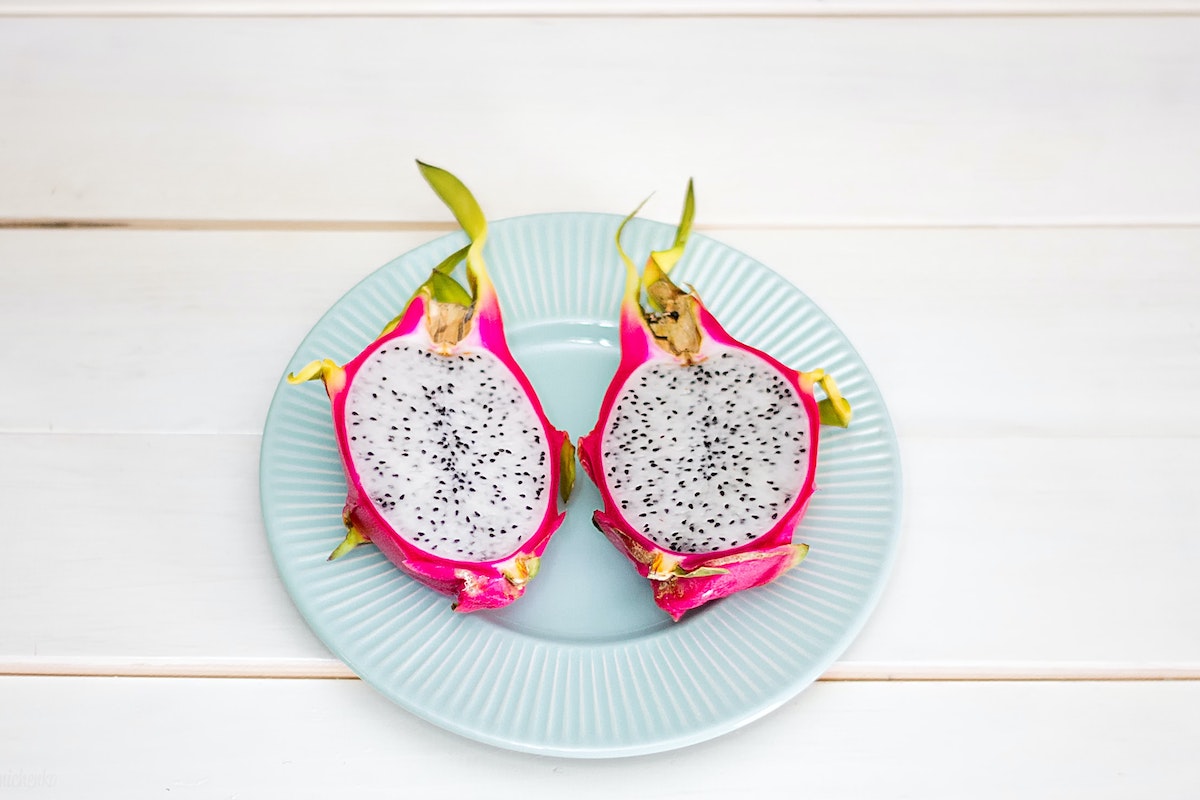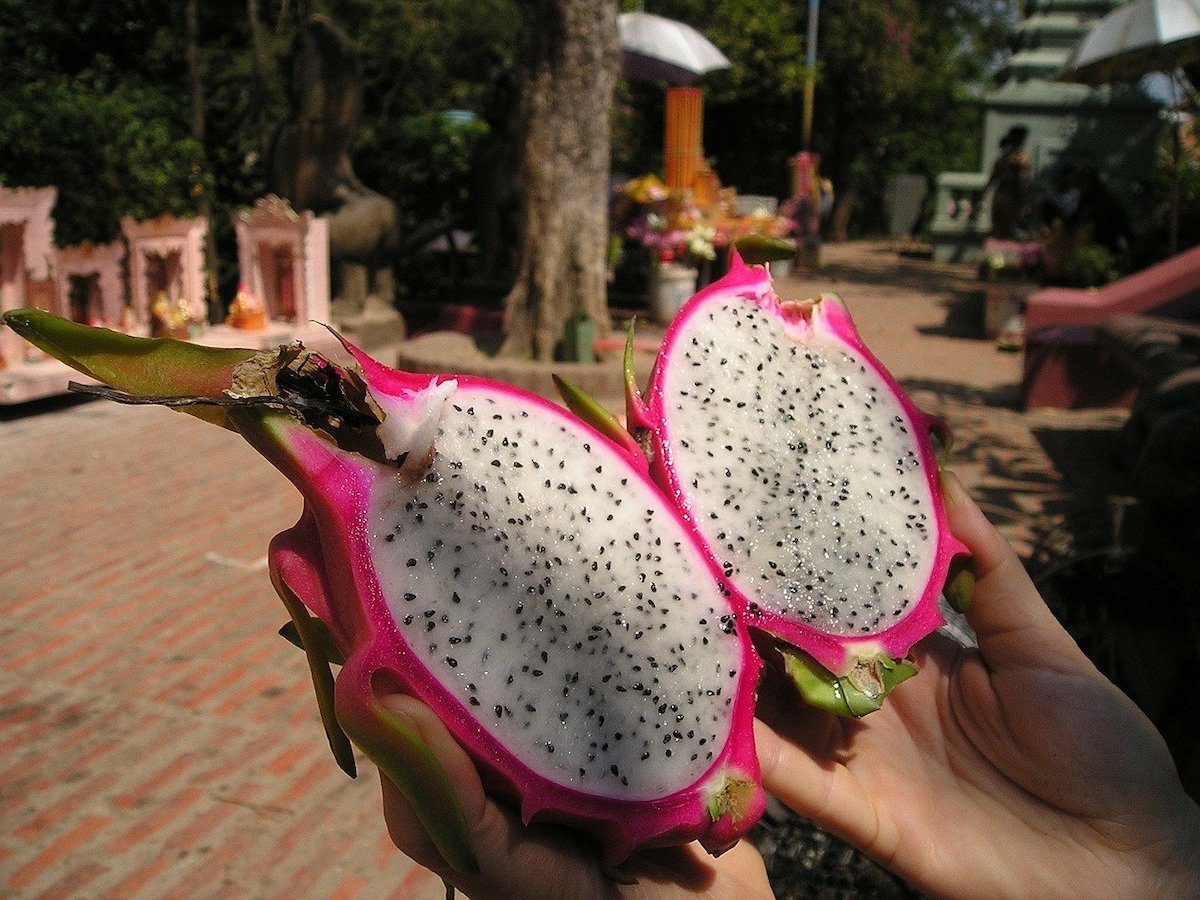
All About the Amazing Dragon Fruit! How to Eat It, Health Benefits & More
By: Nick Callos
Skip to Section
Article Summary
Ready to shake up your grocery list? Dragon fruit looks like something from a sci-fi movie with its hot pink spiky skin, but this tropical treat tastes like a sweet mix of pear and kiwi.
You’ll get the full scoop on choosing, cutting, and eating this exotic fruit (way simpler than its alien appearance suggests), plus all the reasons your body will thank you for trying it. The guide breaks down where to find dragon fruit near you or on your travels, from big chain stores to specialty markets to fruit stands in Costa Rica.
- Wait until dragon fruit feels soft and tender before eating – firm ones need a few days on the counter to ripen.
- Just cut it in half, peel away the inedible skin, and enjoy the white flesh and edible black seeds – or scoop it out like ice cream.
- One 6-ounce serving delivers fiber, vitamin C, magnesium, and antioxidants for only 102 calories.
- Dragon fruit boosts your immune system, supports heart health, feeds good gut bacteria, and might help control blood sugar.
- Shop for it at Asian markets, Latin grocery stores, Kroger, Whole Foods, or order from Amazon and specialty fruit websites.
Are you stuck in a food rut?
We have a fix for that: the dragon fruit (aka pitaya).
Vibrant and nutritious, the dragon fruit is unlike any food you’ve ever seen. First, the name is cool. Second, the leather-like skin and prominent scaly spikes give the exterior psychedelic vibes.
At first glance, you may think this exotic fruit should be in Alice in Wonderland. You’re right — it should.
Open a dragon fruit up, and you’ll discover reddish-white flesh that’s juicy and covered with black seeds (which you can eat). Take a bite, and you’ll notice the sweet, refreshing flavor of this tropical fruit. It tastes like a blended pear and kiwi with an added touch of sweetness.
Want to learn more about the amazing dragon fruit?
Read on. In this article, we’ll cover:
- How to eat dragon fruit
- The health benefits of dragon fruit
- Where to buy dragon fruit (including travel destinations where dragon fruit is available)
How to Eat Dragon Fruit
Dragon fruit comes from the cactus Hylocereus, which primarily grows in tropical Asia, Mexico, Central America, and South America. With its pink-red skin and dragon-like spikes, the fruit may appear difficult to eat. However, it’s quite simple.
But before we cover how to eat dragon fruit, let’s go over how to make sure your dragon fruit is ready to eat. Obviously, when shopping for the fruit, avoid ones with bruises, brown marks, and other issues. And if it’s firm when you buy it, experts suggest letting it ripen on your counter for a few days. Once the fruit is soft and tender (but not mushy), it’s ready to eat.
A Step-by-Step Overview on How to Eat Dragon Fruit
- Grab a chef’s knife. You can’t cut this fruit with a small butter knife!
- Cut the fruit right down the center. Then, cut both pieces in half so you have 4 pieces.
- Peel off the exterior on each piece. This ‘shell’ should come off smoothly using your hand. If it doesn’t, use a spoon to scoop off the fruit or a knife to cut out pieces of the exterior that stay on the fruit.
- Dice your dragon fruit into sweet little spheres (or whatever shape you like).
Note: The seeds are edible. The exterior is NOT edible.
As you can see, learning how to eat dragon fruit isn’t complicated. You just need a knife, spoon, and some patience to make sure the pitaya is ripe and ready to eat. You can even skip steps 3 and 4 above and use a spoon to scoop out chunks of the fruit. The exterior can literally function like a bowl for the fruit flesh.
Now that you know how to eat dragon fruit, you may wonder what foods it compliments well. Here are some ideas:
- Make a fruit salad with other tropical fruits, such as mango and pineapple.
- Pair it with mahi-mahi or any other grilled fish.
- Put it in your morning yogurt alongside nuts.
- Use it as one of your smoothie ingredients.
- Eat it alone! It’s nutritious and delicious.
Health Benefits of Dragon Fruit
Dragon fruit is an excellent source of fiber and essential vitamins and minerals. It’s also fat-free and low in calories.
According to WebMD, a 6-ounce serving of dragon fruit has:
- 102 calories
- 0 grams of fat
- 13 grams of sugar
- 5 grams of fiber
- 2 grams of protein
- 22 grams of carbohydrates
- 31 milligrams of calcium
- 68 milligrams of magnesium
- 4 milligrams of vitamin C
- 100 international units of vitamin A
- 1 gram of iron
Given all the nutrients in dragon fruit, your body and mind will benefit from eating it. Lots of studies are being done to understand all the benefits of dragon fruit. From promoting skin health to reducing inflammation, it’s clear dragon fruit can boost your health in a myriad of ways.
Here’s a quick list of the dragon fruit’s main health benefits:
Immune Support
Rich in vitamin C and other antioxidants, such as flavonoids and phenolic acids, dragon fruit boosts your immune system and neutralizes free radicals (which can damage your cells and cause diseases like cancer).
Improved Cardiovascular Health
Dragon fruit contains heart-healthy fiber and antioxidants. The seeds are rich in healthy fatty acids that benefit the heart, like omega-3. Additionally, iron in dragon fruit helps give you energy and transport oxygen through your body.
Gut Benefits
Dragon fruit contains prebiotics (which feed probiotics). Studies have shown dragon fruit thus promotes the growth of healthy bacteria in your gut. This improves gut health and boosts your digestive system.
Lower Blood Sugar Levels
Since dragon fruit is packed with antioxidants, eating it helps you replace your pancreas’ damaged cells. This helps with producing insulin and breaking down sugar better. This is why the Defeat Diabetes Foundation says dragon fruit is potentially useful for type 2 diabetes management or prevention.*
Where to Buy Dragon Fruit
Dragon fruit has become increasingly popular, and should even be available in larger supermarkets in your hometown. For instance, Kroger and Whole Foods in the United States typically have dragon fruit in stock at locations in large urban areas. You can also check farmer’s markets.
Another option is to visit a local Asian market or Latin American grocery store. Since the dragon fruit is native to Asia, Mexico, Central America, and South America, specialty shops with foods from those areas should have the fruit in stock.
You can also buy dragon fruit online. Amazon and Walmart allow you to order dragon fruit on their sites. You can also support smaller fruit stores online, such as Melissa’s Produce and Miami Fruit.
And of course, if you’re traveling in Costa Rica, Thailand, or another country where dragon fruit grows, pick up a few from a fruit stand or store.
It’s Time to Crack Open a Dragon Fruit
Now you know all about the pitaya (aka dragon fruit). You know how to eat the dragon fruit, its health benefits, and where to buy it.
There are only two things left to do: Buy some dragon fruit and eat it!
About the Author
Nick Callos has always had a passion for reading, writing, and discovering the new and unknown. Originally from Cincinnati, Ohio, Nick holds a Bachelor’s Degree in English from Boston College. He currently splits his time between his hometown, Chengdu, China, and the open road. A full-time travel writer, Nick hopes his work can inspire others to explore the world more deeply and enjoy the digital nomad lifestyle.Featured image via Unsplash.
* Link removed
Information published on this website and across our networks can change over time. Stories and recommendations reflect the subjective opinions of our writers. You should consult multiple sources to ensure you have the most current, safe, and correct details for your own research and plans.
Frayed Passport is a participant in the Amazon Associates Program, an affiliate advertising program designed to provide a means for sites to earn advertising fees by advertising and linking to Amazon.com. We also may share links to other affiliates and sponsors in articles across our website.





